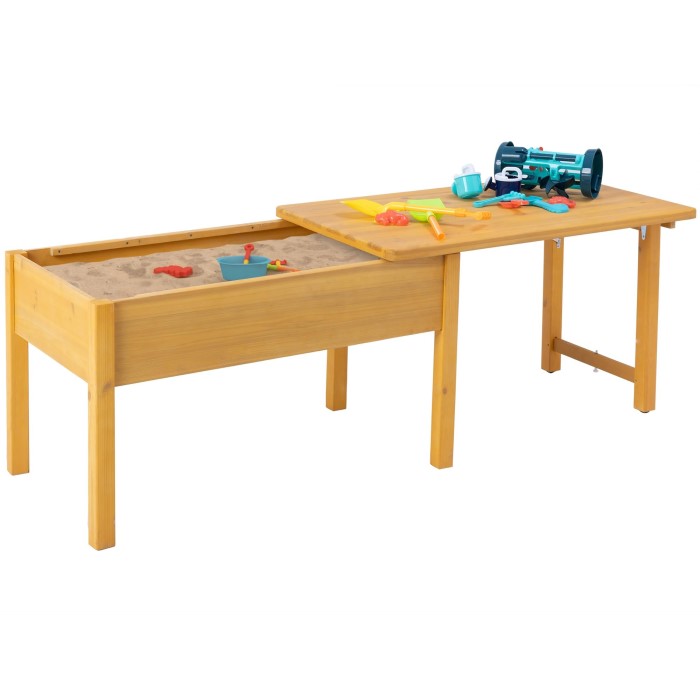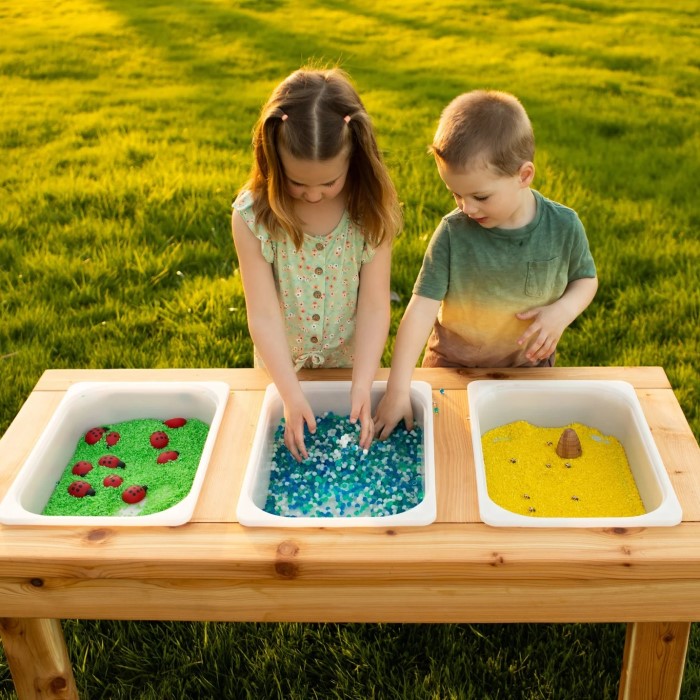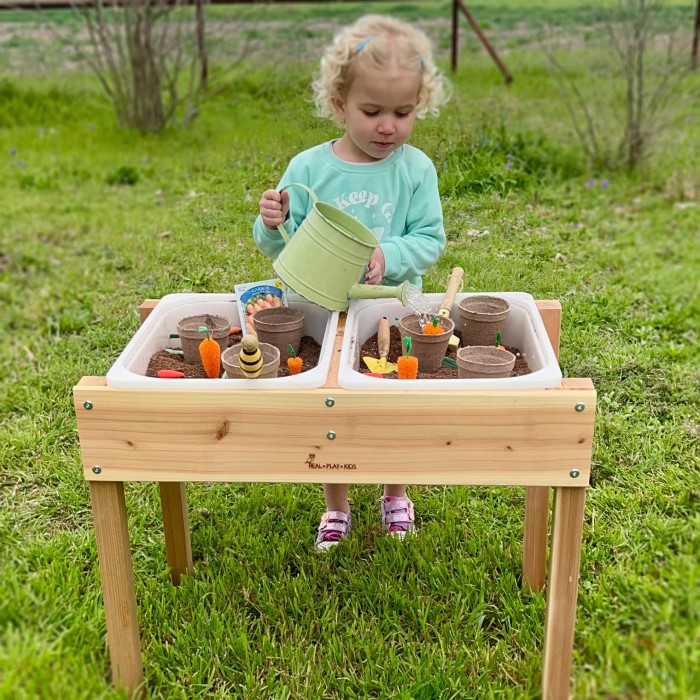Introduction: The Importance of Sensory Play
Sensory play is critical for children’s development, providing them with valuable opportunities to explore their surroundings through touch, taste, sound, sight, and smell. One effective way to engage children in sensory exploration is through a kids sensory table. Sensory tables can be tailored to various themes, ensuring that learning is both educational and entertaining. In this article, we will explore fun ideas for kids sensory tables that will boost creativity and engagement in 2025. From exciting materials to hands-on activities, we have a multitude of suggestions that will captivate young minds and foster their natural curiosity.
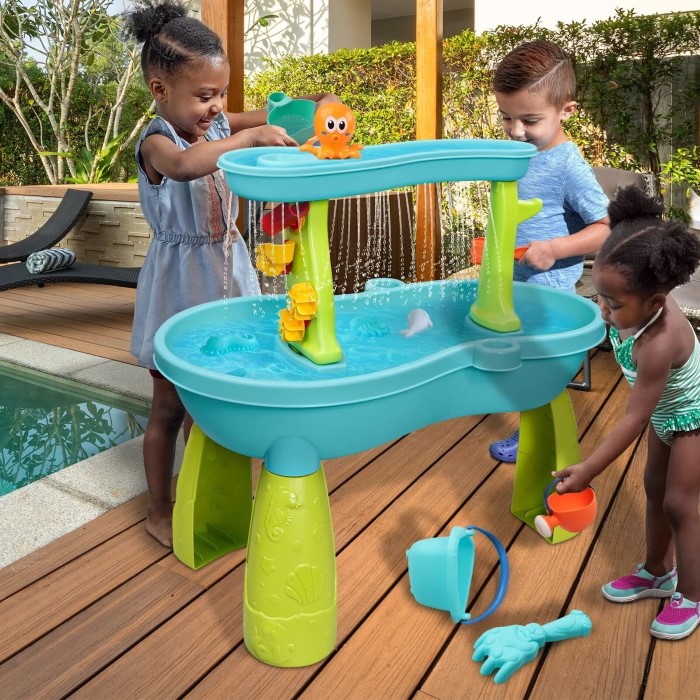
Benefits of Using a Sensory Table for Kids
Sensory tables offer countless benefits for a child’s growth and development. These interactive play spaces help children learn while having fun. Let’s explore the specific advantages sensory tables provide.
Cognitive and Developmental Advantages
Sensory tables support early learning by enhancing problem-solving and critical thinking skills. Hand-eye coordination develops when kids scoop, pour, and maneuver small tools. Activities like sorting objects or experimenting with textures stimulate brain activity. These experiences build foundational skills for math, science, and reasoning. By engaging multiple senses, sensory tables boost memory and learning retention effectively.
Encouraging Creativity and Imagination
Sensory tables inspire creativity by providing endless possibilities for play. With various materials, kids create their own stories and scenarios. For instance, they may build miniature landscapes with sand or imagine underwater worlds with water beads. Open-ended play encourages resourcefulness and innovative thinking. This fosters artistic exploration and imaginative growth in young minds.
Promoting Social and Emotional Growth
Playing at a sensory table helps children build essential social skills. They learn to share, take turns, and collaborate with others. Group activities encourage empathy and teamwork during play. Sensory tables also offer a calming effect, reducing anxiety and boosting emotional well-being. Engaging in sensory play allows kids to explore emotions in a safe and supportive environment.
Different Types of Sensory Tables
Kids sensory tables come in various types to fit different needs. Choosing the right table depends on your space, budget, and the child’s preferences. Here, we will explore two primary categories of sensory tables.
Indoor vs. Outdoor Sensory Tables
Indoor Sensory Tables:
- Ideal for year-round fun inside your home or classroom.
- Provide a clean, controlled environment for sensory play without weather interruptions.
- Suitable materials include rice, beans, water, sand, or kinetic sand.
- Often smaller, portable, and easy to store when not in use.
- Encourage mess-free play with customizable bins or trays to catch spills.
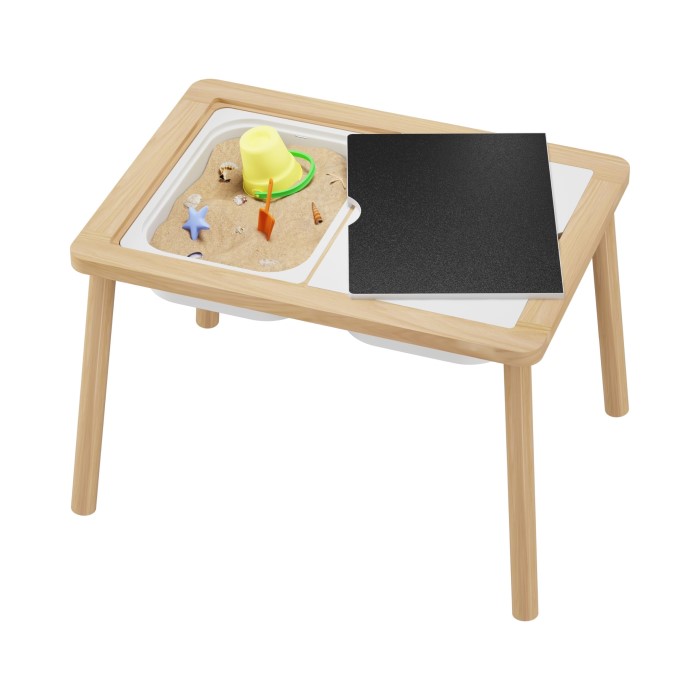
Outdoor Sensory Tables:
- Perfect for using messy and larger-scale materials like mud, water, or gravel.
- Encourage connection to nature while playing with outdoor-safe tools and materials.
- Accommodate more extensive setups, like water fountains or dirt pits for digging.
- Often built with sturdy, weather-resistant materials to last through outdoor conditions.
- Provide kids with free space to explore without worrying about indoor messes.
DIY Sensory Tables vs. Store-Bought Options
DIY Sensory Tables:
- Cost-effective and customizable to your child’s preferences.
- Made using household items like plastic bins, crates, or recycled materials.
- Allow for creativity in size, design, and material choice.
- Can be modified for specific themes or activities.
- Perfect for parents and caregivers who enjoy crafting or upcycling.
Store-Bought Options:
- Convenient and often designed with safety in mind, like rounded edges and durable materials.
- Offer a variety of ready-made features such as built-in compartments, adjustable heights, or covers.
- Save time and allow for quick setup without DIY effort.
- Widely available in child-friendly designs and themes to suit various interests.
- Typically come with a warranty, ensuring a worry-free investment.
By considering your space, budget, and preferred materials, you can choose the sensory table that works best for your family. Whether indoor or outdoor, DIY or store-bought, these tables bring valuable sensory play right into your child’s hands.
Essential Materials for a Sensory Table
Choosing the right materials for a kids sensory table is crucial for safe and engaging play. These items should enhance creativity while remaining safe for young children.
Safe and Non-Toxic Supplies
When selecting supplies for sensory play, prioritize materials that are safe and non-toxic. Look for items labeled “child-safe” to ensure they meet safety standards. Avoid materials with sharp edges or harmful chemicals. Common safe supplies include water-based items, dried rice, beans, and food-grade coloring. Organic materials like sand, feathers, and natural stones also work well for sensory exploration. Always supervise sensory activities to ensure safe use and prevent accidents.
Tools for Scooping, Pouring, and Sorting
Provide kids with tools to make their sensory play more interactive and fun. Scooping tools like spoons or small cups encourage fine motor skill development. Funnels and measuring cups help with pouring exercises, teaching kids coordination and control. Sorting tools like tongs or small baskets encourage problem-solving and organizational skills. Choose sturdy, easy-to-handle tools that are appropriate for your child’s age and abilities.
Recommended Textures and Materials
A variety of textures keeps sensory play exciting and engaging. Soft textures like play dough, fabric scraps, or foam provide tactile stimulation. Wet textures, such as water beads or sponges, add an element of curiosity. Dry materials like dried pasta, seeds, or crushed cereal offer safe exploration. For outdoor setups, mud, gravel, and wet sand provide messy fun. Ensure all materials are clean, hypoallergenic, and easy to replace when needed. Mixing textures can inspire creativity and enhance sensory experiences.
Seasonal and Themed Ideas for Sensory Tables
Seasonal and themed sensory table setups bring fresh excitement to kids’ playtime. These ideas combine fun and learning with creativity, ensuring children stay engaged year-round.
Spring and Summer Activities
Spring and summer sensory tables highlight vibrant colors and outdoor-inspired themes. Use flower petals, green leaves, and seeds for spring setups. Include tools for planting pretend gardens or sorting natural objects. For summer, try water-based activities like mini pools, sandcasts, or seashell sorting. Incorporate beach-themed items like starfish, play sand, and water toys for an immersive experience. Outdoor sensory tables can also feature cool textures like shaved ice or water beads to beat the heat.
Fall and Winter Themes
Fall offers sensory fun with leaves, acorns, corn kernels, or pinecones. Kids can explore autumn colors and textures while using scooping tools or sorting baskets. Spice-scented items like cinnamon sticks or dried orange slices create an aromatic sensory activity. Winter themes can include artificial snow, cotton balls, or ice cubes for a chilly experience. Add holiday figurines or glitter for extra sparkle. Create winter landscapes with small trees and polar animals for imaginative play.
Holiday-Themed Sensory Table Ideas
Holiday-themed sensory tables make celebrations even more special. At Easter, try filling a table with colorful eggs, shredded paper “grass,” and bunnies for sorting activities. Use spooky items like fake spiders, dried corn, or soft fabric for Halloween setups. Christmas tables can include ornaments, jingle bells, and red-and-green pom-poms. These festive creations spark excitement while encouraging kids to engage their senses creatively. Integrate educational themes by including counting objects or themed puzzles in the setup.
Seasonal and themed ideas transform everyday sensory tables into memorable experiences for children. Tailor them to holidays, seasons, and weather for year-long sensory fun.
Water Play and Aquatic Sensory Activities
Water play and aquatic sensory activities are irresistible for kids. These setups offer endless fun and learning opportunities. Water-based sensory tables engage your child’s senses while fostering creativity and exploration.
Floating and Sinking Experiments
Floating and sinking experiments introduce basic scientific concepts in a fun way. Fill a sensory table with water and gather objects of varying weights and materials. Let kids test which items float and which ones sink. Use materials like toy boats, rubber ducks, cork pieces, and small rocks. Ask questions to spark curiosity, like “Why does this object float?” Encourage kids to think critically by predicting outcomes beforehand. These experiments teach concepts like buoyancy, density, and weight.
Using Water Beads and Sponges
Water beads and sponges add enchanting textures to water play. Soak water beads beforehand to let them expand. These squishy, colorful beads are fun for scooping, sorting, and touching. Sponges bring a soft and absorbent texture, great for squeezing and soaking water. Have kids experiment with transferring water using sponges, promoting fine motor skills. For added creativity, use colored water or let kids mix beads by size or color.
Setting Up a Mini Water Park
Transform your sensory table into a mini water park for unforgettable fun. Include materials like spray bottles, toy water slides, or miniature fountains. Add cups and funnels for pouring activities or build little water channels using household items. Incorporate floating toys that kids can navigate through the water channels. Even simple setups using bowls and small sprinklers can spark endless enthusiasm. This activity encourages imaginative play and keeps kids cool during warmer months.
Mess-Free Sensory Table Ideas
Mess-free sensory tables minimize cleanup while offering fun and engaging activities for kids. With clever use of materials, you can create exciting setups without worrying about spills or stains. Here are some practical mess-free options to try.
Using Dry Materials Like Beans and Rice
Dry materials like beans and rice are ideal for mess-free play. They are easy to contain and offer great tactile experiences. Use small scoops, funnels, and trays to enhance play without creating a mess. You can dye rice with food coloring to add vibrant hues. Sorting activities with beans and rice improve fine motor skills and organizational abilities. Always supervise kids during play to keep these materials safely contained.
Creating with Kinetic Sand and Dough
Kinetic sand and dough provide hours of mess-free creativity. Kinetic sand sticks to itself, making cleanup simple. Kids can mold, build, and carve shapes using tools like cookie cutters or popsicle sticks. Play dough offers similar benefits, but ensure it’s non-toxic and safe if ingested. Both materials encourage imaginative play and strengthen hand muscles. Provide trays or mats to keep messes contained during sensory table activities.
Magnet and Magnetic Play Options
Magnet-based sensory tables are clean and engaging. Incorporate magnetic balls, wands, or letters for activities involving attraction and repulsion. Kids can explore basic science concepts with magnetic play while sorting and arranging objects. Magnetic tiles or marbles bring building and design fun without the mess. Ensure all magnetic pieces are age-appropriate and avoid small items that could be choking hazards. A magnetic whiteboard or tray can serve as the perfect base for these activities.
Mess-free sensory table setups simplify cleanup and keep kids entertained. These ideas offer safe, hands-on exploration tailored to minimize mess, making sensory play enjoyable for kids and caregivers alike.
Incorporating Learning into Sensory Play
Sensory play can be a powerful way to combine fun with learning. By introducing educational elements into play, parents and educators can enhance a child’s cognitive growth. Below are some creative ways to incorporate learning into sensory table activities.
Alphabet and Number Learning Activities
Integrate letters and numbers into sensory play to build language and math skills. Use foam letters or magnetic numbers and hide them in materials like rice or sand. Have kids dig through and identify the items they find. Encourage letter tracing in kinetic sand to promote letter recognition. For numbers, use counting activities like placing the correct amount of beads into labeled cups. These tasks make learning interactive and enjoyable.
Exploring Basic Science Concepts
Sensory tables are perfect for introducing basic science. Use a water table to demonstrate concepts like evaporation or temperature changes. Add magnets to explore attraction and repulsion with various objects. Other ideas include creating mini-volcano experiments using baking soda and vinegar. Sand layers in a clear bin can introduce the idea of natural strata. These activities spark curiosity and provide hands-on scientific discovery.
Introducing Problem Solving Through Play
Sensory play can help build problem-solving skills in a natural and engaging way. Create simple puzzles such as matching objects by size or shape. Add small obstacles in water channels to challenge kids to redirect the flow. Introduce tools like tweezers or tongs and have them retrieve specific objects from the sensory table. Offer clues or create scenarios that encourage logical thinking and creative solutions. This cultivates critical thinking in a fun, pressure-free environment.
Tips for Maintaining and Cleaning a Sensory Table
Proper maintenance saves time and keeps kids sensory tables safe and enjoyable. Follow these practical tips.
Storage Solutions for Materials
Organizing sensory table materials ensures they stay clean and accessible:
- Use labeled bins for different materials like beads or sand.
- Stackable containers save space and make it easy to find items.
- Store wet items separately to prevent spills or mold.
- Use zip-top bags for small tools like scoops or sorting tools.
- Keep materials in a cool, dry place to avoid damage.
Cleaning Hacks for Messy Play
Clean sensory tables efficiently after fun activities:
- Wipe surfaces with warm soapy water to remove residue.
- Use disinfectant wipes for extra sanitation, especially after group play.
- Shake out dry materials like beans or rice to reuse clean portions.
- Rinse tools like funnels and scoops underwater after messy activities.
- Allow wet items like sponges to air dry completely before storing.
Safety Tips for Supervised Play
Ensure kids stay safe during sensory table activities:
- Always supervise children to prevent choking hazards or misuse of materials.
- Use age-appropriate items based on your child’s ability to handle them safely.
- Check all materials for sharp edges, mold, or broken parts before play.
- Teach kids how to clean up spills to prevent accidents.
- Limit play to non-toxic, child-safe materials for peace of mind.
Maintaining and cleaning your kids sensory table ensures long-term fun and safety!
Conclusion: Unlocking Creativity through Sensory Play
In summary, a kids sensory table provides an engaging way for children to explore their surroundings while enhancing their creativity and cognitive development. From nature-inspired activities to edible sensory bins, options are plentiful and exciting.
Integrating various thematic ideas and DIY options allows parents and educators to tailor the sensory play experience to their children’s interests. Not only does this create a memorable atmosphere, but it also fosters learning and growth. Utilize these fun ideas to create captivating sensory tables that will inspire and engage kids in 2025! Embrace the wonders of sensory exploration and watch as children thrive in their playful learning journey!
